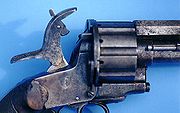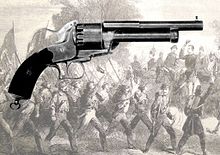
A revolver is a repeating handgun that has at least one barrel and uses a revolving cylinder containing multiple chambers for firing. Because most revolver models hold up to six cartridges, before needing to be reloaded, revolvers are commonly called six shooters or sixguns. Due to their rotating cylinder mechanism, they may also be called wheel guns.

A cartridge, also known as a round, is a type of pre-assembled firearm ammunition packaging a projectile, a propellant substance and an ignition device (primer) within a metallic, paper, or plastic case that is precisely made to fit within the barrel chamber of a breechloading gun, for convenient transportation and handling during shooting. Although in popular usage the term "bullet" is often used to refer to a complete cartridge, the correct usage only refers to the projectile.

The Colt Single Action Army is a single-action revolver handgun. It was designed for the U.S. government service revolver trials of 1872 by Colt's Patent Firearms Manufacturing Company and was adopted as the standard-issued pistol of the U.S. Army from 1873 to 1892.

The pepper-box revolver or simply pepperbox is a multiple-barrel firearm, mostly in the form of a handgun, that has three or more gun barrels in a revolving mechanism. Each barrel holds a single shot, and the shooter can manually rotate the whole barrel assembly to sequentially index each barrel into alignment with the lock or hammer, similar to rotation of a revolver's cylinder.

A rim-fire is a type of metallic cartridge used in firearms where the primer is located within a hollow circumferential rim protruding from the base of its casing. When fired, the gun's firing pin will strike and crush the rim against the edge of the barrel breech, sparking the primer compound within the rim, and in turn ignite the propellant within the case. Invented in 1845 by Louis-Nicolas Flobert, the first rimfire metallic cartridge was the .22 BB Cap cartridge, which consisted of a percussion cap with a bullet attached to the top. While many other different cartridge priming methods have been tried since the early 19th century, such as teat-fire and pinfire, only small caliber rimfire cartridges have survived to the present day with regular use. The .22 Long Rifle rimfire cartridge, introduced in 1887, is by far the most common ammunition found in the world today in terms of units manufactured and sold.

The Smith & Wesson Model 29 is a six-shot, double-action revolver chambered for the .44 Magnum cartridge and manufactured by the United States company Smith & Wesson.

Ethan Allen was a major American arms maker from Massachusetts. He is unrelated to the revolutionary Ethan Allen. His first firearm, the "Pocket rifle" was developed in 1836, and his first patent was granted in 1837.
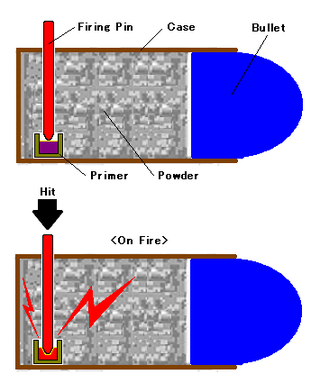
The pin-fire is a type of metallic cartridge used in firearms, where the priming compound is ignited by striking a small pin that protrudes radially from above the base of the cartridge. Invented by Frenchman Casimir Lefaucheux in 1832, but not patented until 1835, it was one of the earliest practical designs of a metallic cartridge to hasten the loading and firing process of a firearm. Its history is closely associated with the development of the breechloader, which would eventually replace all muzzle-loading firearms.

The .32 S&W Long, also known as 7.65x23mm, is a straight-walled, centerfire, rimmed handgun cartridge, based on the earlier .32 S&W cartridge. It was introduced in 1896 for Smith & Wesson's first-model Hand Ejector revolver. Colt called it the .32 Colt New Police in revolvers it made chambered for the cartridge.
A rim is an external flange that is machined, cast, molded, stamped, or pressed around the bottom of a firearms cartridge. Thus, rimmed cartridges are sometimes called "flanged" cartridges. Almost all cartridges feature an extractor or headspacing rim, in spite of the fact that some cartridges are known as "rimless cartridges". The rim may serve a number of purposes, including providing a lip for the extractor to engage, and sometimes serving to headspace the cartridge.
Robert Adams was a 19th-century British gunsmith who patented the first successful double-action revolver in 1851. His revolvers were used during the Crimean War, the Indian Mutiny, the American Civil War, and the Anglo-Zulu War.

The Smith & Wesson Model 10, previously known as the Smith & Wesson .38 Hand Ejector Model of 1899, the Smith & Wesson Military & Police or the Smith & Wesson Victory Model, is a K-frame revolver of worldwide popularity. In production since 1899, the Model 10 is a six-shot, .38 Special, double-action revolver with fixed sights. Over its long production run it has been available with barrel lengths of 2 in (51 mm), 3 in (76 mm), 4 in (100 mm), 5 in (130 mm), and 6 in (150 mm). Barrels of 2.5 inches (64 mm) are also known to have been made for special contracts. Some 6,000,000 of the type have been produced over the years, making it the most-produced handgun of the 20th century.

Harrington & Richardson Arms Company is an American brand of firearms and a subsidiary of JJE Capital Holdings. H&R ceased independent production February 27, 2015.
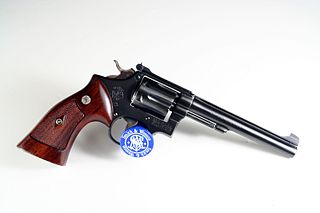
The Smith & Wesson Model 17 is a six-shot double-action revolver chambered for .22 LR. It is built on Smith & Wesson's medium-sized K-frame.

An antique firearm is a term used to describe a firearm that was designed and manufactured prior to the beginning of the 20th century. Although the exact definition of what constitutes an "antique firearm" varies between countries, the advent of smokeless powder or the start of the Boer War are often used as cut-off dates. Antique firearms are usually collected because of their historical interest and/or their monetary value.

A handgun is a firearm designed to be usable with only one hand. It is distinguished from a long gun which needs to be held by both hands and braced against the shoulder. Handguns have shorter effective ranges compared to long guns, and are much harder to shoot accurately. While most early handguns are single-shot pistols, the two most common types of handguns used in modern times are revolvers and semi-automatic pistols, although other handguns such as derringers and machine pistols also see infrequent usage.

The Colt New Model revolving rifles were early repeating rifles produced by the Colt's Manufacturing Company from 1855 until 1864. The design was essentially similar to revolver type pistols, with a rotating cylinder that held five or six rounds in a variety of calibers from .36 to .64 inches. They were mainly based upon the Colt Model 1855 Sidehammer Pocket Revolver developed by Elisha K. Root. Colt revolving pistols and rifles were attractive mainly because of their high rate of fire. They were used to a limited extent on the Pony Express and made a brief appearance in the American Civil War. However, the rifles were generally disliked by soldiers, and were ultimately discontinued due to serious design flaws.

In firearms, the cylinder is the cylindrical, rotating part of a revolver containing multiple chambers, each of which is capable of holding a single cartridge. The cylinder rotates (revolves) around a central axis in the revolver's action to sequentially align each individual chamber with the barrel bore for repeated firing. Each time the gun is cocked, the cylinder indexes by one chamber. Serving the same function as a rotary magazine, the cylinder stores ammunitions within the revolver and allows it to fire multiple times before needing to reload.
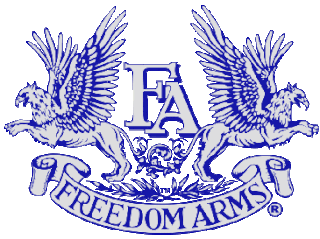
Freedom Arms is a Freedom, Wyoming based firearm manufacturing company, known for producing powerful single-action revolvers. The company was founded in 1978 by Wayne Baker and Dick Casull to produce the Mini-Revolver, then later a revolver chambered in Casull's powerful .454 Casull revolver cartridge. This 5-shot revolver was the Model 83. Freedom Arms currently makes a single-shot pistol in addition to their revolvers.

The Colt House Revolver was one of the first metallic cartridge rear-loading revolvers to be produced by the Colt's Patent Fire Arms Manufacturing Company, in 1871. The same year, Colt's also patented the Colt Open Top, another metallic cartridge rear-loader, but in fact the Open Top production didn't start until 1872, although a pocket version of the Open Top, a completely different design, went on sales as of 1871, the Colt Open Top Pocket Model Revolver.



